Pole vault
Pole vaulting is a track and field event in which a person uses a long flexible pole (which today is usually made either of fiberglass or carbon fiber) as an aid to jump over a bar. Pole jumping competitions were known to the ancient Greeks, Cretans and Celts. It has been a full medal event at the Olympic Games since 1896 for men and since 2000 for women.
| Athletics Pole vault | |
|---|---|
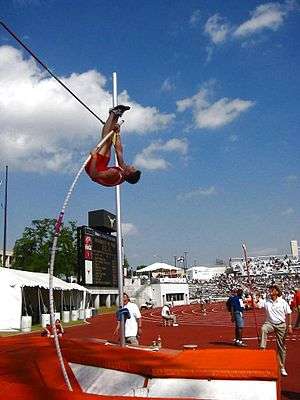 An athlete in the middle of the vaulting phase | |
| World records | |
| Men | |
| Women | |
| Olympic records | |
| Men | |
| Women | |
It is typically classified as one of the four major jumping events in athletics, alongside the high jump, long jump and triple jump. It is unusual among track and field sports in that it requires a significant amount of specialised equipment in order to participate, even at a basic level. A number of elite pole vaulters have had backgrounds in gymnastics, including world record breakers Yelena Isinbayeva and Brian Sternberg, reflecting the similar physical attributes required for the sports.[1][2] Running speed, however, may be the most dominant factor. Physical attributes such as speed, agility and strength are essential to pole vaulting effectively, but technical skill is an equally if not more important element. The object of pole vaulting is to clear a bar or crossbar supported upon two uprights (standards) without knocking it down.
History

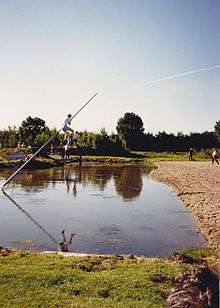
Poles were used as a practical means of passing over natural obstacles in marshy places such as the province of Friesland in the Netherlands, along the North Sea, and the great level of the Fens in England across Cambridgeshire, Huntingdonshire, Lincolnshire and Norfolk. Artificial draining of these marshes created a network of open drains or canals intersecting each other. To cross these without getting soaked, while avoiding tedious roundabout journeys over bridges, a stack of jumping poles was kept at every house and used for vaulting over the canals.
Distance pole vaulting competitions continue to be held annually in the lowlands around the North Sea. These far-jumping competitions (Frisian: Fierljeppen) are not based on height.[3]
In his book The Mechanics of the Pole Vault, Richard Ganslen reports that the London Gymnastic Society under Professor Voelker held measured pole vaulting events in 1826, involving 1,300 participants and recording heights up to 10 ft 10 in (3.3 m).[4] Other early pole vaulting competitions where height was measured took place at the Ulverston Football and Cricket Club, Lancashire, north of the sands (now Cumbria) in 1843.[5] Modern competition began around 1850 in Germany, when pole vaulting was added to the exercises of the Turner gymnastic clubs by Johann C. F. GutsMuths and Friedrich L. Jahn. In Great Britain, it was first practiced at the Caledonian Games.
Initially, vaulting poles were made from stiff materials such as bamboo or aluminum. The introduction of flexible vaulting poles in the early 1950s made from composites such as fiberglass or carbon fiber allowed vaulters to achieve greater height.[6]

In 2000, IAAF rule 260.18a (formerly 260.6a) was amended, so that "world records" (as opposed to "indoor world records") can be set in a facility "with or without roof". This rule was not applied retroactively,[7] With many indoor facilities not conforming to outdoor track specifications for size and flatness, the pole vault is the only world record set indoors.
Modern vaulting
Today, athletes compete in the pole vault as one of the four jumping events in track and field. Because the high jump and pole vault are both vertical jumps, the competitions are conducted similarly. Each athlete can choose what height they would like to enter the competition. Once they enter, they have three attempts to clear the height. If a height is cleared, the vaulter advances to the next height, where they will have three more attempts. Once the vaulter has three consecutive misses, they are out of the competition and the highest height they cleared is their result. A "no height", often denoted "NH", refers to the failure of a vaulter to clear any bar during the competition.
Once the vaulter enters the competition, they can choose to pass heights. If a vaulter achieves a miss on their first attempt at a height, they can pass to the next height, but they will only have two attempts at that height, as they will be out once they achieve three consecutive misses. Similarly, after earning two misses at a height, they could pass to the next height, when they would have only one attempt.
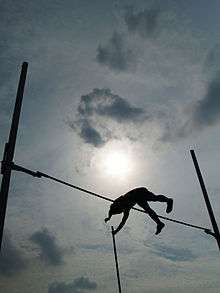
The competitor who clears the highest height is the winner. If two or more vaulters have finished with the same height, the tie is broken by the number of misses at the final height. If the tied vaulters have the same number of misses at the last height cleared, the tie is broken by the total number of misses in the competition.
If there is still a tie for first place, a jump-off occurs to break the tie. Marks achieved in this type of jump-off are considered valid and count for any purpose that a mark achieved in a normal competition would.
If a tie in the other places still exists, a jump-off is not normally conducted, unless the competition is a qualifying meet, and the tie exists in the final qualifying spot. In this case, an administrative jump-off is conducted to break the tie, but the marks are not considered valid for any other purpose than breaking the tie.
A jump-off is a sudden death competition in which the tied vaulters attempt the same height, starting with the last attempted height. If both vaulters miss, the bar goes down by a small increment, and if both clear, the bar goes up by a small increment. A jump-off ends when one vaulter clears and the other misses. Each vaulter gets one attempt at each height until one makes and one misses.
The equipment and rules for pole vaulting are similar to the high jump. Unlike high jump, however, the athlete in the vault has the ability to select the horizontal position of the bar before each jump and can place it a distance beyond the back of the box, the metal pit that the pole is placed into immediately before takeoff. The range of distance the vaulter may place the standards varies depending on the level of competition.
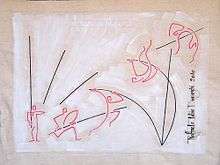
If the pole used by the athlete dislodges the bar from the uprights, a foul attempt is ruled, even if the athlete has cleared the height. An athlete does not benefit from quickly leaving the landing pad before the bar has fallen. The exception to this rule if the vaulter is vaulting outdoors and has made a clear effort to throw the pole back, but the wind has blown the pole into the bar; this counts as a clearance. This call is made at the discretion of the pole vault official. If the pole breaks during the execution of a vault, it is considered an equipment failure and is ruled a non-jump, neither a make nor a miss. Other types of equipment failure include the standards slipping down or the wind dislodging the bar when no contact was made by the vaulter.
Each athlete has a set amount of time in which to make an attempt. The amount of time varies by level of competition and the number of vaulters remaining. If the vaulter fails to begin an attempt within this time, the vaulter is charged with a time foul and the attempt is a miss.
Poles are manufactured with ratings corresponding to the vaulter's maximum weight. Some organizations forbid vaulters to use poles rated below their weight as a safety precaution. The recommended weight corresponds to a flex rating that is determined by the manufacturer by placing a standardized amount of stress (most commonly a 50 lb (23 kg) weight) on the pole and measuring how much the center of the pole is displaced. Therefore, two poles rated at the same weight are not necessarily the same stiffness.
Because pole stiffness and length are important factors to a vaulter's performance, it is not uncommon for an elite vaulter to carry as many as ten poles to a competition. The effective properties of a pole can be changed by gripping the pole higher or lower in relation to the top of the pole. The left and right handgrips are typically a bit more than shoulder width apart. Poles are manufactured for people of all skill levels and body sizes, with sizes as short as 3.05 m (10 ft 0 in) to as long as 5.30 m (17 ft 5 in), with a wide range of weight ratings. Each manufacturer determines the weight rating for the pole and the location of the maximum handhold band.
However speed is the most essential element to higher jumps, because the energy produced by the run is converted to vertical propulsion . Assuming no loss of energy , this means that .
Technology
Competitive pole vaulting began using solid ash poles. As the heights attained increased, the bamboo poles gave way to tubular aluminum,[8] which was tapered at each end. Today's pole vaulters benefit from poles produced by wrapping pre-cut sheets of fiberglass that contains resin around a metal pole mandrel, to produce a slightly curved pole that bends more easily under the compression caused by an athlete's take-off. The shape of the fiberglass sheets and the amount of fiberglass used is carefully planned to provide the desired length and stiffness of pole. Different fiber types, including carbon-fiber, are used to give poles specific characteristics intended to promote higher jumps. In recent years, carbon fiber has been added to the commonly used E-glass and S-glass materials to create a lighter pole.
As in the high jump, the landing area was originally a heap of sawdust or sand where athletes landed on their feet. As technology enabled higher vaults, mats evolved into bags of large chunks of foam. Today's high-tech mats are foam usually 1–1.5 meters (3 ft 3 in–4 ft 11 in) thick. Mats are growing larger in area as well to minimize risk of injury. Proper landing technique is on the back or shoulders. Landing on the feet should be avoided, to eliminate the risk of injury to the lower extremities, particularly ankle sprains.
Rule changes over the years have resulted in larger landing areas and additional padding of all hard and unyielding surfaces.
The pole vault crossbar has evolved from a triangular aluminum bar to a round fiberglass bar with rubber ends. This is balanced on standards and can be knocked off when it is hit by a pole vaulter or the pole. Rule changes have led to shorter pegs and crossbar ends that are semi-circular.
Technique
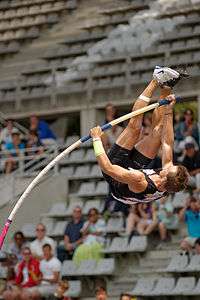
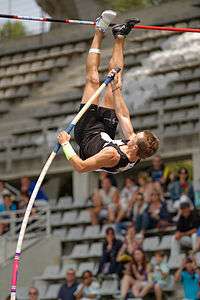
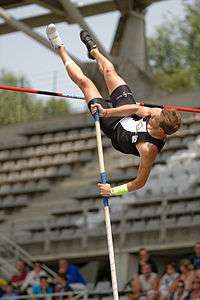
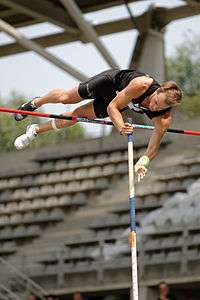
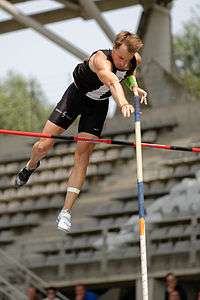
Although many techniques are used by vaulters at various skill levels to clear the bar, the generally accepted technical model can be broken down into several phases:
Approach
During the approach the pole vaulter sprints down the runway in such a way as to achieve maximum speed and correct position to initiate takeoff at the end of the approach. Top class vaulters use approaches with 18 to 22 strides, often referred to as a "step" in which every other foot is counted as one step. The run-up to the vaulting pit begins forcefully with the vaulter running powerfully in a relaxed, upright position with knees lifted and torso leaning very slightly forward. The head, shoulders and hips are aligned, the vaulter increasing speed as the body becomes erect. The tip of the vaulting pole is angled higher than eye level until three paces from takeoff, when the pole tip descends efficiently, amplifying run speed as the pole is planted into the vault box. The faster the vaulter can run and the more efficient their take-off is, the greater the kinetic energy that can be achieved and used during the vault.
Plant and take-off
The plant and take off is initiated typically three steps out from the final step. Vaulters will usually count their steps backwards from their starting point to the box only counting the steps taken on the left foot (vice versa for left-handers) except for the second step from the box, which is taken by the right foot. For example; a vaulter on a "ten count" (referring to the number of counted steps from the starting point to the box) would count backwards from ten, only counting the steps taken with the left foot, until the last three steps taken and both feet are counted as three, two, one. These last three steps are normally quicker than the previous strides and are referred to as the "turn-over". The goal of this phase is to efficiently translate the kinetic energy accumulated from the approach into potential energy stored by the elasticity of the pole, and to gain as much initial vertical height as possible by jumping off the ground. The plant starts with the vaulter raising their arms up from around the hips or mid-torso until they are fully outstretched above the head, with the right arm extended directly above the head and the left arm extended perpendicular to the pole (vice versa for left-handed vaulters). At the same time, the vaulter is dropping the pole tip into the box. On the final step, the vaulter jumps off the trail leg which should always remain straight and then drives the front knee forward. As the pole slides into the back of the box the pole begins to bend and the vaulter continues up and forward, leaving the trail leg angled down and behind.
Swing up
The swing and row simply consists of the vaulter swinging the trail leg forward and rowing the pole, bringing the top arm down to the hips, while trying to keep the trail leg straight to store more potential energy into the pole, the rowing motion also keeps the pole bent for a longer period of time for the vaulter to get into optimum position. Once in a "U" shape the left arm hugs the pole tight to efficiently use the recoil within the pole. The goal is to carry out these motions as thoroughly and as quickly as possible; it is a race against the unbending of the pole. Effectively, this causes a double pendulum motion, with the top of the pole moving forward and pivoting from the box, while the vaulter acts as a second pendulum pivoting from the right hand. This action gives the vaulter the best position possible to be "ejected" off the pole. The swing continues until the hips are above the head and the arms are pulling the pole close to the chest; from there the vaulter shoots their legs up over the cross bar while keeping the pole close.[9][10]
Extension
The extension refers to the extension of the hips upward with outstretched legs as the shoulders drive down, causing the vaulter to be positioned upside down. This position is often referred to as "inversion". While this phase is executed, the pole begins to recoil, propelling the vaulter quickly upward. The hands of the vaulter remain close to the body as they move from the shins back to the region around the hips and upper torso.
Turn
The turn is executed immediately after or even during the end of the rockback. As the name implies, the vaulter turns 180° toward the pole while extending the arms down past the head and shoulders. Typically the vaulter will begin to angle their body toward the bar as the turn is executed, although ideally the vaulter will remain as vertical as possible. A more accurate description of this phase of the vault may be "the spin" because the vaulter spins around an imaginary axis from head to toe.
Fly-away
This is often highly emphasized by spectators and novice vaulters, but it is the easiest phase of the vault and is a result of proper execution of previous phases. This phase mainly consists of the vaulter pushing off the pole and releasing it so it falls away from the bar and mats. As the torso goes over and around the bar, the vaulter is facing the bar. Rotation of the body over the bar occurs naturally, and the vaulter's main concern is making sure that their arms, face and any other appendages do not knock the bar off as they go over. The vaulter should land near the middle of the foam landing mats, or pits, face up.
Terminology
- Bar
- The cross bar that is suspended above the ground by the standards.
- Box
- A trapezoidal indentation in the ground with a metal or fiberglass covering at the end of the runway in which vaulters "plant" their pole. The back wall of the box is nearly vertical and is approximately 8 inches (20 cm) in depth. The bottom of the box gradually slopes upward approximately 3 feet (90 cm) until it is level with the runway. The covering in the box ensures the pole will slide to the back of the box without catching on anything. The covering's lip overlaps onto the runway and ensures a smooth transition from all-weather surface so a pole being planted does not catch on the box.
- Drive knee
- During the plant phase, the knee is driven forward at the time of "takeoff" to help propel the vaulter upward.
- Grip
- The location of the vaulter's top hand on the pole. As the vaulter improves, their grip may move up the pole incrementally. The other hand is typically placed shoulder-width down from the top hand. Hands are not allowed to grip the very top of the pole (their hand perpendicular to the pole) for safety reasons.
- Jump foot
- The foot that the vaulter uses to leave the ground as they begin their vault. It is also referred to as the take-off foot.
- Pit
- The mats used for landing in pole vault.
- Plant position
- The position a vaulter is in the moment the pole reaches the back of the box and the vaulter begins their vault. Their arms are fully extended and their drive knee begins to come up as they jump.
- Pole
- The fiberglass equipment used to propel the vaulter up and over the bar. One side is stiffer than the other to facilitate the bending of the pole after the plant. A vaulter may rest the pole on their arm to determine which side is the stiff side.
- Standards
- The equipment that holds the bar at a particular height above the ground. Standards may be adjusted to raise and lower the bar and also to adjust the horizontal position of the bar.
- Steps
- Since the box is in a fixed position, vaulters must adjust their approach to ensure they are in the correct position when attempting to vault.
- Swing leg or trail leg
- The swing leg is also the jump foot. After a vaulter has left the ground, the leg that was last touching the ground stays extended and swings forward to help propel the vaulter upwards.
- Volzing
- A method of holding or pushing the bar back onto the pegs while jumping over a height. This takes considerable skill, although it is now against the rules and counted as a miss. The technique is named after U.S. Olympian Dave Volz, who made an art form of the practice and surprised many by making the U.S. Olympic team in 1992.
All-time top 25 athletes
- Key
set prior to IAAF acceptance of certain indoor marks for world records (in 2000)
Men (comprehensive)
| Rank | Mark | Athlete | Date | Venue | Ref |
|---|---|---|---|---|---|
| 1 | 6.18 m (20 ft 3 in) | 15 February 2020 | Glasgow (indoor) | ||
| 2 | 6.16 m (20 ft 2 1⁄2 in) | 15 February 2014 | Donetsk (indoor) | [13] | |
| 3 | 6.15 m (20 ft 2 in) | 21 February 1993 | Donetsk (indoor) | ||
| 4 | 6.06 m (19 ft 10 1⁄2 in) | 7 February 2009 | Boston (indoor) | ||
| 27 July 2019 | Des Moines | [14] | |||
| 6 | 6.05 m (19 ft 10 in) | 16 June 1999 | Athens | ||
| 9 August 2001 | Edmonton | ||||
| 8 | 6.04 m (19 ft 9 3⁄4 in) | 8 June 2008 | Eugene | ||
| 9 | 6.03 m (19 ft 9 1⁄4 in) | 18 August 1995 | Cologne | ||
| 14 June 2000 | Jonesboro | ||||
| 15 August 2016 | Rio de Janeiro | [15] | |||
| 12 | 6.02 m (19 ft 9 in) | ||||
| 4 February 1989 | Gomel (indoor) | ||||
| 12 July 2019 | Monaco | [16] | |||
| 14 | 6.01 m (19 ft 8 1⁄2 in) | 4 July 1996 | Saint Petersburg | ||
| 18 September 2004 | Monaco | ||||
| 1 July 2008 | Bydgoszcz | ||||
| 5 September 2012 | Aachen | ||||
| 18 | 6.00 m (19 ft 8 in) | 27 August 1997 | Cologne | ||
| 6 March 1999 | Maebashi (indoor) | ||||
| 11 February 2001 | Dortmund (indoor) | ||||
| 8 May 2004 | Modesto | ||||
| 25 February 2005 | Perth | ||||
| 12 August 2018 | Berlin | [17] | |||
| 6.00 m (19 ft 8 in) A | 15 January 2016 | Reno (indoor) | [18] | ||
| 25 | 5.98 m (19 ft 7 1⁄4 in) | 25 May 1996 | Knoxville |
Notes
Below is a list of all other vaults equal or superior to 6.00 m:
- Armand Duplantis also vaulted 6.17 m (20 ft 2 3⁄4 in) (2020i), 6.07 m (19 ft 10 3⁄4 in) (2020i), 6.05 m (19 ft 10 in) (2018), 6.01 m (19 ft 8 1⁄2 in) (2020i) and 6.00 m (19 ft 8 in) (2018, 2019, 2020i).
- Sergey Bubka also vaulted 6.14 m (20 ft 1 1⁄2 in) (1993, 1994), 6.13 m (20 ft 1 1⁄4 in) (1992), 6.12 m (20 ft 3⁄4 in) (1991), 6.11 m (20 ft 1⁄2 in) (1991), 6.10 m (20 ft 0 in) (1991), 6.08 m (19 ft 11 1⁄4 in) (1991), 6.06 m (19 ft 10 1⁄2 in) (1988, 1993), 6.05 m (19 ft 10 in) (1990, 1993, 1994, 1997), 6.03 m (19 ft 9 1⁄4 in) (1987, 1989), 6.02 m (19 ft 9 in) (1996), 6.01 m (19 ft 8 1⁄2 in) (1986, 1993), and 6.00 m (19 ft 8 in) (1985, 1989, 1991, 1992, 1994, 1995).
- Renaud Lavillenie also vaulted 6.08 m (19 ft 11 1⁄4 in) (2014), 6.05 m (19 ft 10 in) (2015), 6.04 m (19 ft 9 3⁄4 in) (2014, 2015), 6.03 m (19 ft 9 1⁄4 in) (2011, 2016), 6.02 m (19 ft 9 in) (2015, 2016), 6.01 m (19 ft 8 1⁄2 in) (2009, 2013, 2015) and 6.00 m (19 ft 8 in) (2015).
- Sam Kendricks also vaulted 6.01 m (19 ft 8 1⁄2 in) (2020i) and 6.00 m (19 ft 8 in) (2017, 2019).
- Steve Hooker also vaulted 6.01 m (19 ft 8 1⁄2 in) (2010) and 6.00 m (19 ft 8 in) (2008).
- Piotr Lisek also vaulted 6.01 m (19 ft 8 1⁄2 in) (2019) and 6.00 m (19 ft 8 in) (2017i).
- Radion Gataullin also vaulted 6.00 m (19 ft 8 in) (1989, 1993).
- Maksim Tarasov also vaulted 6.00 m (19 ft 8 in) (1999).
Women (comprehensive)
| Rank | Mark | Athlete | Date | Place | Ref |
|---|---|---|---|---|---|
| 1 | 5.06 m (16 ft 7 in) | 28 August 2009 | Zürich | ||
| 2 | 5.03 m (16 ft 6 in) | 30 January 2016 | Brockport (indoor) | [21] | |
| 3 | 5.00 m (16 ft 4 3⁄4 in) | 9 September 2016 | Brussels | [22] | |
| 4 | 4.95 m (16 ft 2 3⁄4 in) | 29 September 2019 | Doha | [23] | |
| 29 February 2020 | Moscow (indoor) | [24] | |||
| 5 | 4.94 m (16 ft 2 1⁄4 in) | 17 July 2018 | Jockgrim | [25] | |
| 6 | 4.92 m (16 ft 1 1⁄2 in) | 1 August 2020 | Marietta | [26] | |
| 7 | 4.91 m (16 ft 1 1⁄4 in) | 2 August 2015 | Beckum | ||
| 6 August 2017 | London | [27] | |||
| 9 | 4.90 m (16 ft 3⁄4 in) | 20 February 2016 | New York City (indoor) | [28] | |
| 10 | 4.88 m (16 ft 0 in) | 4 July 2004 | Heraklion | ||
| 11 | 4.87 m (15 ft 11 1⁄2 in) | 21 January 2012 | Villeurbanne (indoor) | ||
| 3 July 2016 | São Bernardo do Campo | [29] | |||
| 13 | 4.85 m (15 ft 10 3⁄4 in) | 6 March 2011 | Paris (indoor) | ||
| 14 | 4.83 m (15 ft 10 in) | 8 June 2004 | Ostrava | ||
| 4 July 2015 | Saint-Denis | [30] | |||
| 16 | 4.82 m (15 ft 9 3⁄4 in) | 22 September 2007 | Stuttgart | ||
| 21 July 2012 | Fontvieille | ||||
| 24 August 2019 28 August 2019 |
Paris Zürich (indoor) |
[31][32] | |||
| 19 | 4.81 m (15 ft 9 1⁄4 in) | 2 July 2016 | Sunshine Coast | [33] | |
| 24 February 2019 | Clermont-Ferrand (indoor) | [34] | |||
| 21 | 4.80 m (15 ft 8 3⁄4 in) | 30 August 2011 | Daegu | ||
| 17 March 2016 | Portland (indoor) | [35] | |||
| 23 | 4.78 m (15 ft 8 in) | 19 September 2004 | Monaco | ||
| 19 February 2020 | Liévin (indoor) | [36] | |||
| 25 | 4.77 m (15 ft 7 3⁄4 in) | 7 July 2002 | Wattenscheid |
Notes
Below is a list of all other vaults equal or superior to 4.85 m:
- Yelena Isinbayeva also vaulted 5.05 m (16 ft 6 3⁄4 in) (2008), 5.01 m (16 ft 5 in) (2005, 2012), 5.00 m (16 ft 4 3⁄4 in) (2009), 4.95 m (16 ft 2 3⁄4 in) (2008), 4.93 m (16 ft 2 in) (2007), 4.92 m (16 ft 1 1⁄2 in) (2004), 4.91 m (16 ft 1 1⁄4 in) (2006, 2007), 4.90 m (16 ft 3⁄4 in) (2005, 2016), 4.89 m (16 ft 1⁄2 in) (2013), 4.86 m (15 ft 11 1⁄4 in) (2004), 4.85 m (15 ft 10 3⁄4 in) (2010, 2011).
- Jennifer Suhr also vaulted 5.02 m (16 ft 5 1⁄2 in) (2013), 5.01 m (16 ft 5 in) (2016), 4.93 m (16 ft 2 in) (2018), 4.92 m (16 ft 1 1⁄2 in) (2008), 4.91 m (16 ft 1 1⁄4 in) (2011, 2013, 2019), 4.89 m (16 ft 1⁄2 in) (2010), 4.88 m (16 ft 0 in) (2007, 2012), 4.87 m (15 ft 11 1⁄2 in) (2018), 4.86 m (15 ft 11 1⁄4 in) (2011), 4.85 m (15 ft 10 3⁄4 in) (2018, 2020i).
- Sandi Morris also vaulted 4.95 m (16 ft 2 3⁄4 in) (2016, 2018i), 4.93 m (16 ft 2 in) (2016), 4.91 m (16 ft 1 1⁄4 in) (2020i), 4.90 m (16 ft 3⁄4 in) (2019, 2020i), 4.90 m (16 ft 3⁄4 in) A (2018i), 4.88 m (16 ft 0 in) (2018), 4.87 m (15 ft 11 1⁄2 in) (2017), 4.86 m (15 ft 11 1⁄4 in) (2018i), 4.85 m (15 ft 10 3⁄4 in) (2016, 2018, 2019, 2020i).
- Eliza McCartney also vaulted 4.92 m (16 ft 1 1⁄2 in) (2018), 4.87 m (15 ft 11 1⁄2 in) (2018), 4.86 m (15 ft 11 1⁄4 in) (2018), 4.85 m (15 ft 10 3⁄4 in) (2018, 2019).
- Anzhelika Sidorova also vaulted 4.92 m (16 ft 1 1⁄2 in) (2020i), 4.91 m (16 ft 1 1⁄4 in)i (2019), 4.90 m (16 ft 3⁄4 in) (2018i), 4.87 m (15 ft 11 1⁄2 in) (2018i), 4.86 m (15 ft 11 1⁄4 in) (2018i), 4.85 m (15 ft 10 3⁄4 in) (2016, 2018, 2019i).
- Katie Nageotte also vaulted 4.91 m (16 ft 1 1⁄4 in) (2018i), 4.86 m (15 ft 11 1⁄4 in) (2018i, 2019i).
- Katerina Stefanidi also vaulted 4.90 m (16 ft 3⁄4 in) (2016), 4.87 m (15 ft 11 1⁄2 in) (2017, 2018), 4.86 m (15 ft 11 1⁄4 in) (2016), 4.85 m (15 ft 10 3⁄4 in) (2016, 2017, 2018, 2019).
- Fabiana Murer also vaulted 4.85 m (15 ft 10 3⁄4 in) (2010).
Six metres club
The "six metres club" consists of pole vaulters who have reached at least 6.00.[37] In 1985 Sergey Bubka became the first pole vaulter to clear six metres.
| Measure | Athlete | Nation | Outdoors | Indoors | Year first cleared 6 metres |
|---|---|---|---|---|---|
| 6.18 | Armand Duplantis | 6.05 | 6.18 | 2018 | |
| 6.16 | Renaud Lavillenie | 6.05 | 6.16 | 2009 | |
| 6.15 | Sergey Bubka | 6.14 | 6.15 | 1985 | |
| 6.06 | Steve Hooker | 6.00 | 6.06 | 2008 | |
| Sam Kendricks | 6.06 | 6.01 | 2017 | ||
| 6.05 | Maksim Tarasov | 6.05 | 6.00 | 1997 | |
| Dmitri Markov | 6.05 | 5.85 | 1998 | ||
| 6.04 | Brad Walker | 6.04 | 5.86 | 2006 | |
| 6.03 | Okkert Brits | 6.03 | 5.90 | 1995 | |
| Jeff Hartwig | 6.03 | 6.02 | 1998 | ||
| Thiago Braz da Silva | 6.03 | 5.93 | 2016 | ||
| 6.02 | Rodion Gataullin | 6.00 | 6.02 | 1989 | |
| Piotr Lisek | 6.02 | 6.00 | 2017 | ||
| 6.01 | Igor Trandenkov | 6.01 | 5.90 | 1996 | |
| Timothy Mack | 6.01 | 5.85 | 2004 | ||
| Yevgeniy Lukyanenko | 6.01 | 5.90 | 2008 | ||
| Björn Otto | 6.01 | 5.92 | 2012 | ||
| 6.00 | Tim Lobinger | 6.00 | 5.95 | 1997 | |
| Jean Galfione | 5.98 | 6.00 | 1999 | ||
| Danny Ecker | 5.93 | 6.00 | 2001 | ||
| Toby Stevenson | 6.00 | 5.81 | 2004 | ||
| Paul Burgess | 6.00 | 5.80 | 2005 | ||
| Shawnacy Barber | 5.93 | 6.00 | 2016 | ||
| Timur Morgunov | 6.00 | 5.91 | 2018 | ||
Five metres club
Three women have cleared 5 metres. Yelena Isinbayeva was the first to clear 5.00 m (16 ft 4 3⁄4 in) on July 22, 2005. On March 2, 2013, Jenn Suhr cleared 5.02 m (16 ft 5 1⁄2 in) indoors to become the second. Sandi Morris cleared 5.00 meters on September 9, 2016, to become the third.
| Measure | Athlete | Nation | Outdoors | Indoors | Year first
cleared 5 metres |
|---|---|---|---|---|---|
| 5.06 | Yelena Isinbayeva | 5.06 | 5.01 | 2005 | |
| 5.03 | Jennifer Suhr | 4.93 | 5.03 | 2013 | |
| 5.00 | Sandi Morris | 5.00 | 4.95 | 2016 | |
Milestones
This is a list of the first time a milestone height was cleared.[38]
| Measure | Athlete | Nation | Date |
|---|---|---|---|
| 13 ft (3.96 m) | Robert Gardner | 1 June 1912 | |
| 4 m (13 ft 1 1⁄2 in) | Marc Wright | 8 June 1912 | |
| 14 ft (4.27 m) | Sabin Carr | 27 May 1927 | |
| 4.5 m (14 ft 9 in) | William Sefton [39] | 29 May 1937 | |
| 15 ft (4.57 m) | Cornelius "Dutch" Warmerdam | 13 April 1940 | |
| 16 ft (4.88 m) | John Uelses | 31 March 1962 | |
| 5 m (16 ft 5 in) | Brian Sternberg | 27 April 1963 | |
| 17 ft (5.18 m) | John Pennel | 24 August 1963 | |
| 18 ft (5.49 m) | Christos Papanikolaou | 24 October 1970 | |
| 5.5 m (18 ft 1⁄2 in) | Kjell Isaksson | 8 April 1972 | |
| 19 ft (5.79 m) | Thierry Vigneron | 20 June 1981 | |
| 6 m (19 ft 8 in) | Sergey Bubka | 13 July 1985 | |
| 20 ft (6.10 m) | Sergey Bubka | 16 March 1991 (indoors) 5 August 1991 (outdoors) | |
Olympic medalists
Men
Women
World Championships medalists
Men
Women
| Championships | Gold | Silver | Bronze |
|---|---|---|---|
| 1999 Seville |
|||
| 2001 Edmonton |
|||
| 2003 Saint-Denis |
|||
| 2005 Helsinki |
|||
| 2007 Osaka |
|||
| 2009 Berlin |
none awarded | ||
| 2011 Daegu |
|||
| 2013 Moscow |
|||
| 2015 Beijing |
|||
| 2017 London |
|||
| 2019 Doha |
World Indoor Championships medalists
Men
- A Known as the World Indoor Games
Women
Season's bests
Men
|
Women
|
- "i" denotes indoor performance.
- "A" denotes performance at higher than 1,000 metres (3,300 ft) altitude.
Notes and references
- Rosenbaum, Mike. Yelena Isinbayeva: Pole Vault Record-Breaker. About Track and Field. Retrieved on 25 January 2014.
- Rudman, Steve (31 May 2013). Huskies vault legend Brian Sternberg (1943-13). Sports Press NW. Retrieved on 2014-01-25.
- "Info". Polsstokverspringen/ Fierljeppen Holland. 5 September 2012. Archived from the original on 2 October 2012. Retrieved 7 September 2012.
- Jan., Johnson (2007). Illustrated history of the pole vault. VerSteeg, Russ., Kring, Ray. Norwich, CT: [publisher not identified]. p. 19. ISBN 9780979174605. OCLC 191809409.
- Turnbull, Simon (13 June 2009). Kate Dennison: 'It helps being a little bit crazy'. The Independent. Retrieved on 2009-06-15.
- "Ocala Star-Banner - Google News Archive Search". news.google.com. Retrieved 25 January 2019.
- "12th IAAF World Championships In Athletics: IAAF Statistics Handbook. Berlin 2009" (PDF). Monte Carlo: IAAF Media & Public Relations Department. 2009. p. 546. Archived from the original (PDF) on 29 June 2011. Retrieved 17 August 2009.
- McCormick, Matthew. "Soaring to New Heights: The Evolution of Pole Vaulting and Pole Materials" Archived 26 February 2014 at the Wayback Machine. Illumin. Retrieved on 25 January 2014.
- McGinnis, Peter (December 2015). "Mechanics of the pole vault" (PDF). usatf.org.
- "How to Do the Pole Vault in Track and Field". ThoughtCo. Retrieved 2 May 2018.
- Pole Vault - men - senior - outdoor. IAAF. Retrieved on 25 January 2014.
- Pole Vault - men - senior - indoor. IAAF. Retrieved on 8 February 2020.
- "Sergey Bubka's pole vault record broken by Renaud Lavillenie". BBC Sport. 16 February 2014. Retrieved 2 May 2018.
- Roy Jordan (28 July 2019). "Kendricks tops 6.06m in Des Moines". IAAF. Retrieved 29 July 2019.
- "Men's Pole Vault Results" (PDF). Rio 2016 official website. 15 August 2016. Archived from the original (PDF) on 20 September 2016. Retrieved 17 August 2016.
- Mike Rowbottom (12 July 2019). "Lisek improves to 6.02m in Monaco – IAAF Diamond League". IAAF. Retrieved 28 July 2019.
- "Men's Pole Vault Results" (PDF). European Athletics. 12 August 2018. Archived from the original (PDF) on 18 March 2018. Retrieved 12 August 2018.
- "Pole Vault Results" (PDF). polevaultsummit.files.wordpress.com. 15 January 2016. Retrieved 16 January 2016.
- Pole Vault - women - senior - outdoor. IAAF. Retrieved on 25 January 2014.
- Pole Vault - women - senior - indoor. IAAF. Retrieved on 25 January 2014.
- "Jenn Suhr Sets Indoor Pole Vault World Record". flotrack.org. 30 January 2016. Retrieved 31 January 2016.
- "Pole Vault Results" (PDF). sportresult.com. 9 September 2016. Retrieved 12 September 2016.
- "Pole Vault Results" (PDF). IAAF. 29 September 2019. Retrieved 2 October 2019.
- Bob Ramsak (1 March 2020). "Indoor round-up: Thiam breaks Belgian indoor long jump record, Stark clocks world U20 indoor 60m hurdles record". World Athletics. Retrieved 26 March 2020.
- Jon Mulkeen (18 July 2018). "McCartney vaults world-leading 4.94m in Jockgrim". IAAF. Retrieved 26 July 2018.
- Bob Ramsak (2 August 2020). "Nageotte tops 4.92m in Atlanta, Reekie and Pozzi shine in Trieste". World Athletics. Retrieved 6 August 2020.
- "Pole Vault Results" (PDF). IAAF. 6 August 2017. Retrieved 6 August 2017.
- "Stefanidi and Payne clear 4.90m at Millrose Games - indoor round-up". IAAF. 21 February 2016. Retrieved 21 February 2016.
- Eduardo Biscayart (3 July 2016). "Murer soars over South American record of 4.87m at Brazilian Championships". IAAF. Retrieved 3 July 2016.
- "Pole Vault Results". IAAF. 4 July 2015. Retrieved 5 July 2015.
- Mike Rowbottom (24 August 2019). "Claye sails beyond 18 metres in Paris – IAAF Diamond League". IAAF. Retrieved 3 September 2019.
- "Pole Vault Results". IAAF. 28 August 2019. Retrieved 22 September 2019.
- "Alana Boyd breaks Australian pole vault record to surge into Rio medal running". The Sydney Morning Herald. 29 January 2016. Retrieved 30 January 2016.
- Jon Mulkeen; Bob Ramsak (25 February 2019). "Indoor round-up: Brazier clocks 600m world best in New York, Lisek and Kendricks clear 5.93m world lead in Clermont Ferrand". IAAF. Retrieved 1 March 2019.
- "Pole Vault Results" (PDF). IAAF. 17 March 2016. Retrieved 18 March 2016.
- "Pole Vault Results". World Athletics. 19 February 2020. Retrieved 19 February 2020.
- US unit calculator for unofficial mark conversions in athletic events, hosted by USATF.org
- "Track and Field Statistics". trackfield.brinkster.net. Retrieved 25 January 2019.
- Note: Earle Meadows cleared the same height minutes later in the same competition
External links
| Wikimedia Commons has media related to Pole vault. |